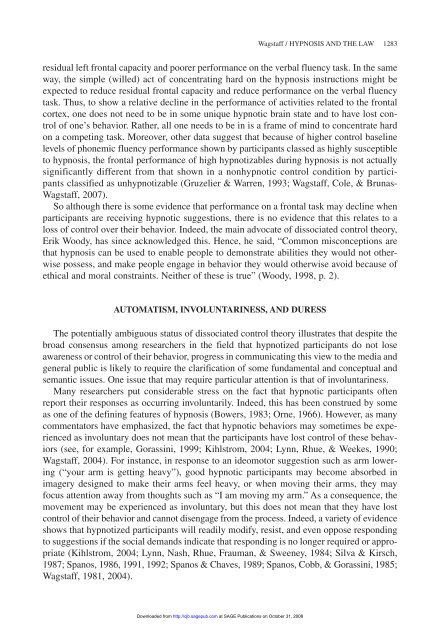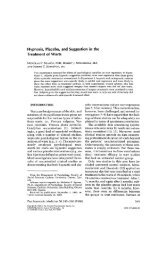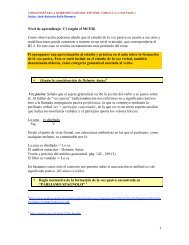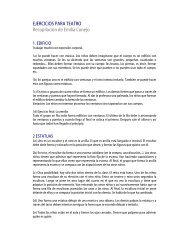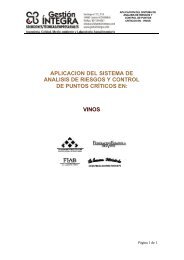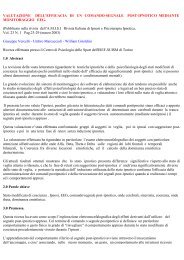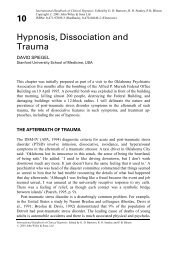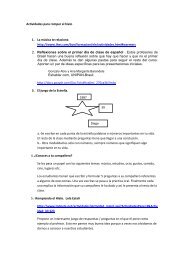Hypnosis and the Law: Examining the Stereotypes
Hypnosis and the Law: Examining the Stereotypes
Hypnosis and the Law: Examining the Stereotypes
You also want an ePaper? Increase the reach of your titles
YUMPU automatically turns print PDFs into web optimized ePapers that Google loves.
esidual left frontal capacity <strong>and</strong> poorer performance on <strong>the</strong> verbal fluency task. In <strong>the</strong> same<br />
way, <strong>the</strong> simple (willed) act of concentrating hard on <strong>the</strong> hypnosis instructions might be<br />
expected to reduce residual frontal capacity <strong>and</strong> reduce performance on <strong>the</strong> verbal fluency<br />
task. Thus, to show a relative decline in <strong>the</strong> performance of activities related to <strong>the</strong> frontal<br />
cortex, one does not need to be in some unique hypnotic brain state <strong>and</strong> to have lost control<br />
of one’s behavior. Ra<strong>the</strong>r, all one needs to be in is a frame of mind to concentrate hard<br />
on a competing task. Moreover, o<strong>the</strong>r data suggest that because of higher control baseline<br />
levels of phonemic fluency performance shown by participants classed as highly susceptible<br />
to hypnosis, <strong>the</strong> frontal performance of high hypnotizables during hypnosis is not actually<br />
significantly different from that shown in a nonhypnotic control condition by participants<br />
classified as unhypnotizable (Gruzelier & Warren, 1993; Wagstaff, Cole, & Brunas-<br />
Wagstaff, 2007).<br />
So although <strong>the</strong>re is some evidence that performance on a frontal task may decline when<br />
participants are receiving hypnotic suggestions, <strong>the</strong>re is no evidence that this relates to a<br />
loss of control over <strong>the</strong>ir behavior. Indeed, <strong>the</strong> main advocate of dissociated control <strong>the</strong>ory,<br />
Erik Woody, has since acknowledged this. Hence, he said, “Common misconceptions are<br />
that hypnosis can be used to enable people to demonstrate abilities <strong>the</strong>y would not o<strong>the</strong>rwise<br />
possess, <strong>and</strong> make people engage in behavior <strong>the</strong>y would o<strong>the</strong>rwise avoid because of<br />
ethical <strong>and</strong> moral constraints. Nei<strong>the</strong>r of <strong>the</strong>se is true” (Woody, 1998, p. 2).<br />
AUTOMATISM, INVOLUNTARINESS, AND DURESS<br />
Wagstaff / HYPNOSIS AND THE LAW 1283<br />
The potentially ambiguous status of dissociated control <strong>the</strong>ory illustrates that despite <strong>the</strong><br />
broad consensus among researchers in <strong>the</strong> field that hypnotized participants do not lose<br />
awareness or control of <strong>the</strong>ir behavior, progress in communicating this view to <strong>the</strong> media <strong>and</strong><br />
general public is likely to require <strong>the</strong> clarification of some fundamental <strong>and</strong> conceptual <strong>and</strong><br />
semantic issues. One issue that may require particular attention is that of involuntariness.<br />
Many researchers put considerable stress on <strong>the</strong> fact that hypnotic participants often<br />
report <strong>the</strong>ir responses as occurring involuntarily. Indeed, this has been construed by some<br />
as one of <strong>the</strong> defining features of hypnosis (Bowers, 1983; Orne, 1966). However, as many<br />
commentators have emphasized, <strong>the</strong> fact that hypnotic behaviors may sometimes be experienced<br />
as involuntary does not mean that <strong>the</strong> participants have lost control of <strong>the</strong>se behaviors<br />
(see, for example, Gorassini, 1999; Kihlstrom, 2004; Lynn, Rhue, & Weekes, 1990;<br />
Wagstaff, 2004). For instance, in response to an ideomotor suggestion such as arm lowering<br />
(“your arm is getting heavy”), good hypnotic participants may become absorbed in<br />
imagery designed to make <strong>the</strong>ir arms feel heavy, or when moving <strong>the</strong>ir arms, <strong>the</strong>y may<br />
focus attention away from thoughts such as “I am moving my arm.” As a consequence, <strong>the</strong><br />
movement may be experienced as involuntary, but this does not mean that <strong>the</strong>y have lost<br />
control of <strong>the</strong>ir behavior <strong>and</strong> cannot disengage from <strong>the</strong> process. Indeed, a variety of evidence<br />
shows that hypnotized participants will readily modify, resist, <strong>and</strong> even oppose responding<br />
to suggestions if <strong>the</strong> social dem<strong>and</strong>s indicate that responding is no longer required or appropriate<br />
(Kihlstrom, 2004; Lynn, Nash, Rhue, Frauman, & Sweeney, 1984; Silva & Kirsch,<br />
1987; Spanos, 1986, 1991, 1992; Spanos & Chaves, 1989; Spanos, Cobb, & Gorassini, 1985;<br />
Wagstaff, 1981, 2004).<br />
Downloaded from<br />
http://cjb.sagepub.com at SAGE Publications on October 31, 2008


